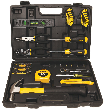Years ago I lived in an old home heated by two wood-and-coal-burning stoves, with stovepipes elbowed to one central chimney. Each year we replaced the stove pipes because experienced neighbors told me that soot and creosote build up inside pipes and chimneys, causing a fire hazard. Because I had never experienced a chimney fire, I didn't understand the importance of cleaning a chimney and opted, instead, to simply replace the pipes.
One cold winter morning, I left the damper of the stove completely open while I went into the kitchen. Walking back through the living room about twenty minutes later, I was horrified to see the stove pipe glowing cherry red, and the paint on the wall abutting the chimney blistering. I slammed the stove damper shut and latched it, heard the stove pipe contract, and held my breath waiting for the stove pipe color to return to black.
Later that day I learned that not only was the chimney full of soot and creosote, the pipes—although new—had developed dangerous deposits of the stuff, as well. Subsequent years had me cleaning the chimney before each winter, ensuring against fire hazards.
While you can hire a professional chimney sweep to clean your chimney, you can very well do it yourself. Follow these guidelines if you want to clean your own chimney:
Once you're back inside the house, unseal the fireplace or stove and remove all of the soot and debris. Carefully remove the tarps, plastic, or sheets and use the shop vac again to remove all traces of soot from the fireplace or stove. Remember to clean your chimney at least once a year. The best time to clean your fireplace and chimney is before using your fireplace or stove the first time of the season.

Find the Right Tool Right Away Finally, a homeowner's set that includes all the tools needed to complete basic DIY projects at an affordable price! The tools are stored in a molded case for security and portability. Check out Stanley 65-Piece Homeowner's Tool Kit today!
Fireplace safety is simply a mixture of common sense and forethought. Here are some simple guidelines to ensure that you ...
Discover MoreFireplaces, particularly wood burning ones, can add a touch of comfort and elegance to just about any room. The trick ...
Discover MoreWhether you are looking into getting rid of your old fireplace due to crumbling bricks, a need for new space, or you want ...
Discover MoreThere are currently no comments for this tip. (Be the first to leave your comment—just use the simple form above!)
Copyright © 2025 Sharon Parq Associates, Inc.
Comments